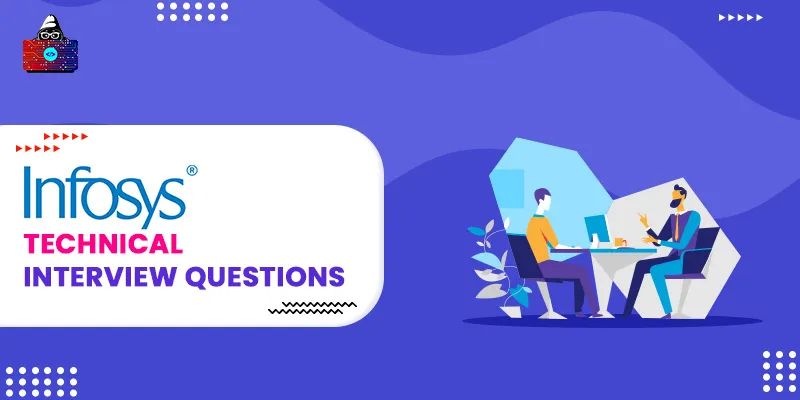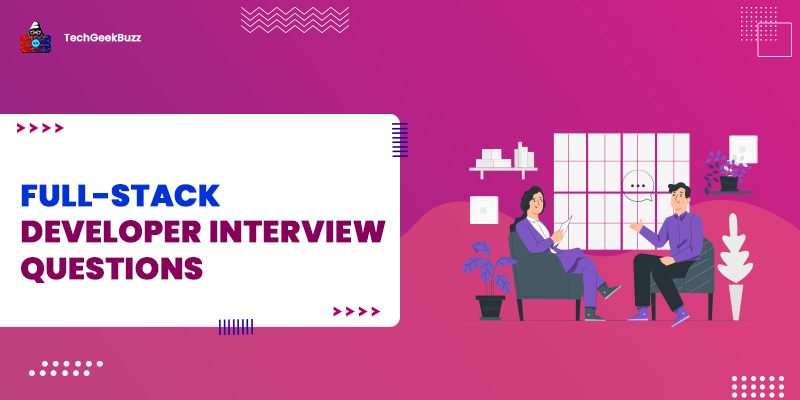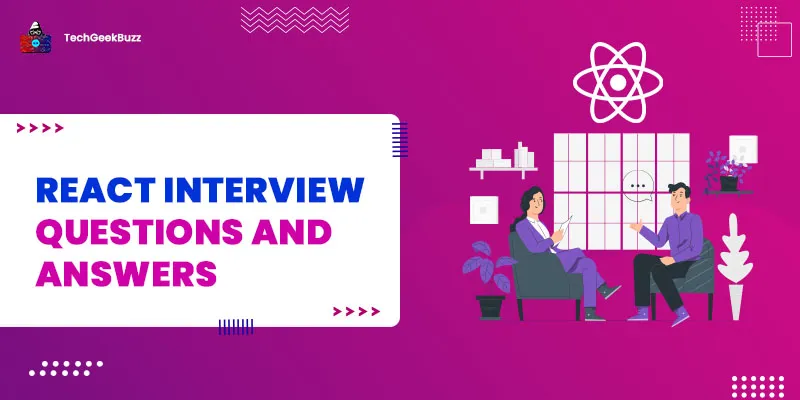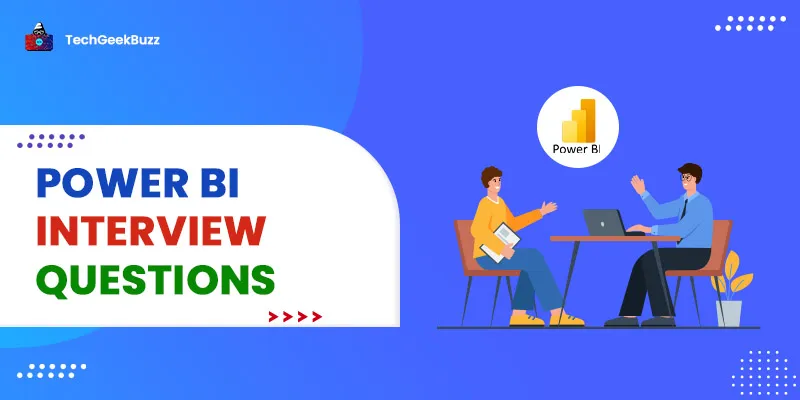Infosys is an Indian MNC among the most prominent IT players in the world. It provides business consulting, information technology, and outsourcing services. In addition, it offers software development, product maintenance, and validation services to various companies in finance, manufacturing, and many other sectors.
In 1981, N. R. Narayana Murthy founded Infosys at Pune. Earlier, the company was known as Infosys Technologies Ltd. Currently, the headquarter of the company is in Banglore, India.
Being one of the most popular and prominent tech giants, it is a dream company for many developers and an excellent platform to kick-start your career in IT. Every year, the company conducts a recruitment drive to hire freshers for the job role of System Engineer.
If you aspire to be a part of this tech giant and are preparing for the interview for the job role of System Engineer, you have landed in the right place.
In this article, we will discuss some commonly asked Infosys interview questions, along with their answers. Also, we shall walk you through the recruitment process of Infosys.
Infosys Recruitment Process
As mentioned above, Infosys conducts a recruitment drive every year for the job role of System Engineer. To apply for this position, individuals must have a minimum of 60% marks in graduation, 12th grade, and 10th grade. The eligible applicants then have to go through three rounds of the recruitment process, as follows:
- Online Assessment Test
- Technical Interview
- HR Interview
Let us discuss each of these rounds in detail below.
1. Online Assessment Test
The online assessment further consists of three different sections, where each section has a specific time limit and the minimum score requirement. The following are the three sections:
- Logical and Analytical Reasoning: This section covers questions on data interpretation, visual reasoning, data sufficiency, syllogism, statement reasoning, etc.
- Quantitative Aptitude: This section entails questions on permutation and combination, speed and distance, number series, algebra, analytical puzzles, time, work, probability, etc.
- Verbal Ability: This round consists of questions on synonyms, antonyms, sentence correction, paragraph completion, vocabulary, fill-in-the-blanks, etc.
2. Technical Interview
Candidates who qualify for the online assessment test appear for the technical interview round. In this round, a panel of interviewers asks domain-based questions. In addition, they ask questions based on your resume and area of interest. Therefore, it is expected from candidates to have knowledge of at least one programming language, data structure, operating systems, computer algorithms, and emerging technologies.
3. HR Interview
Once you qualify for the technical interview, next is the HR interview round. In this round, interviewers validate whether you are fit for the job role. Thus, you may encounter questions related to the job role. Also, you may expect general questions related to your background, hobbies, education, strengths, weaknesses, etc.
Top Infosys Interview Questions and Answers
We have divided the commonly asked Infosys questions and answers into three different parts, namely technical, aptitude, and HR. Let us begin with aptitude interview questions.
Infosys Aptitude Interview Questions and Answers
This section will walk you through some frequently asked aptitude questions that you may expect in the online assessment test.
1. What should be the next number in the series: 4, 2, 1, (1/2), (1/4), ?.
a) (1/3) b) (1/8) c) (2/8) d) (1/16)
Answer: B
Explanation: In the above series, each number is half of its previous number. When we divide each number by 2, we get the next number in the series.
Therefore, 4/2 = 2 2/2 = 1 1/2 = 1/2 (1/2)/2 = 1/4 (1/4)/2 = 1/8
2. John's age after 15 years will be 5 times his age 5 years ago. What is their present age of John?
a) 10 years b) 18 years c) 20 years d) Cannot be determined
Answer: A
Explanation: Let the present age of John be x. John's age after 15 years will be (x+15).
John's age five years back was (x-5).
According to the given condition:
(x+15) = 5*(x-5)
x+15 = 5x - 25
4x = 25+15
4x = 40
x = 10
3. Find the missing number in the following series.
62, 64,______, 32, 14,16
a) 26 b) 28 c) 30 d) 32
Answer: C
Explanation: 62 - 2 = 60/2 = 30 64/2 = 32 30-2 = 28/2 = 14 32/2 = 16
4 . Find the odd one out.
a) Sphere b) Eclipse c) Cube d) Circle
Answer: C
5. Today is Monday. After 60 days, it will be ____
We know that each day is repeated after every 7 days. So, after 63 days, it will be Monday. After 60 days, it will be Friday.
6. What should be the next number in the series?
80, 10, 70, 15, 60, 20, ____ a) 30 b) 20 c) 50 d) 25
Answer: C
Explanation: This is an altering addition and subtraction series. The first series is the subtraction series and the second series is the addition series.
80 - 10 = 70
10 + 5 = 15
70 - 10 = 60
15 + 5 = 20
60 - 10 = 50
7. A place that provides refuge
a) Shelter b) Asylum c) Orphanage d) Sanatorium
Answer: B
8. If 5 men take an hour to dig a ditch, then how long should 12 men take to dig a ditch of the same type?
a) 25 min b) 20 min c) 30 min d) 26 min
Answer: A
Explanation: M1 H1 = M2 H2 5 * 60 = 12 * H2 H2 = 25
9. How many times are the hands of the clock at the right angle in a day?
a) 48 b) 26 c) 44 d) 78
Answer: C
Explanation: In 12 hours, the hands of the clock are at the right angle 22 times. Therefore, the hands of the clock are at the right angle 44 times a day.
10. What will be the next number in the series?
3 17 23 29 31 37 ?
a) 22 b) 19 c) 41 d) 23
Answer: C
Explanation: The given series is the series of prime numbers. The next prime number after 37 is 41.
11. 40 quintals are what percent of 4 metric tonnes?
a) 15 b) 150 c) 5 d) 1500
Answer: B
Explanation: 1 quintal = 100 kg 1 metric ton = 1000 kg According to the condition, 40 ×100 = (x/100) ×2×1000 Solving for x, we get its value as 150%
12. The average salary to be paid to 45 workers is Rs. 10,000 and 15 workers is x. The overall average salary is Rs. 15,000. Find the average monthly salary of these 15 workers.
a) 15000 b) 30000 c) 45000 d) 60000
Answer: B
Explanation:
((45 * 10,000) + (15 * x))/60 = 15000
450,000 + 15x = 15,ooo * 60
15x = 900,000 - 450,000
x = 450,000/15
Hence, the value of x is 30000.
13. What is the cost of fencing a circular field of radius 14 m at the rate of Rs. 2 per meter?
a) 167 b) 176 c) 180 d) 190
Answer: B
Explanation: Given that the radius of the circular field is 14 m.
Therefore, the perimeter of a circular field = 2 * 3.14 * 14 m = 88 m
The cost of fencing = 88 * 2 = Rs 176
14. Find the odd one out.
a) Parsley b) Basil c) Dill d) Mayonnaise
Answer: D
15. Fill in the blank.
The teacher asked if ________ to bring our textbooks to class.
a) all we had remembered
b) we had all remembered c) had all we remembered d) had we all remembered
Answer: B
Infosys Technical Interview Questions and Answers
In this section, we shall discuss some commonly asked technical Infosys questions and answers to help you recollect the concept or brush up on your knowledge.
16. Name some high-level programming languages.
Answer:
- C++
- C#
- Java
- Python
- Go
- Swift
- PHP
- JavaScript
17. C is sometimes considered a low-level programming language. Why so ?
Answer: Though C mainly supports the concept of high-level programming language, it is sometimes considered a low-level programming language because it allows bit-orientated operation, direct memory access, and raw pointers.
18. What is a preprocessor in C?
Answer: The preprocessor is not a part of the compiler but a separate step at the time of compilation. All those commands we write at the top of the program code that starts with a # symbol are preprocessors in C .
19. Name basic OOPs concepts.
Answer: Following are the various OOPs concepts:
- Abstraction
- Encapsulation
- Inheritance
- Polymorphism
20. What is inheritance? Name its types.
Answer: Inheritance is one of the important concepts of OOPs languages. With inheritance, we can apply the properties of one class to another class. The concept of inheritance increases the code reusability of the programming language .
21. Please enumerate the various types of inheritance.
Answer:
- Single inheritance.
- Multi-level inheritance.
- Hierarchical inheritance.
- Multiple inheritances.
- Hybrid inheritance.
- Multipath inheritance.
22. What are tokens in C++?
Answer: Tokens are the smallest elements in C++ that make more sense to a compiler. Identifiers, keywords, literals, operators, punctuations, and other separators are examples of tokens.
23. What is the difference between multi-level and multiple inheritances?
Answer: In multi-level inheritance, the derived class is derived from another derived class. Multiple inheritances, however, happen when a single class derives from multiple base classes.
24. Give some differences between C++ and Java.
Answer:
| Parameters | C++ | Java |
| Platform dependency | C++ is platform-dependent. | It is platform-independent. |
| Usages | It is mainly used for Windows software. | Java is used to build applications for different platforms and web applications. |
| Multiple Inheritance | C++ supports multiple inheritances. | There is no support for multiple inheritances in Java. To achieve so, it has the concept of interfaces . |
| Pointer | Provides support for explicit pointer usage. | Java does not support explicit pointers. |
25. How encapsulation and abstraction are complementary?
Answer: Both encapsulation and abstraction serve a similar purpose but in a distinct manner. Encapsulation is used to wrap the data in a single unit, such as a class, whereas abstraction deals with hiding the data from the user in the form of a class.
26. What are arrays?
Answer: An array is the most important data structure, and every high-level programming language support it. Arrays are a collection of similar data types stored in a contiguous memory location. This makes array elements retrieval very efficient and fast.
27. What is a pointer in C?
Answer: A pointer in C is a variable that stores the address of another variable. Also, the data type of the pointer variable and the variable it is storing should be the same. Pointers are basically used at the time of dynamic memory allocation.
28. Give some differences between C and C++.
Answer: Here are the major differences between C and C++:
| Parameters | C++ | C |
| Type | It is a procedural as well as an object-oriented programming language. | C is a procedural language. |
| Data security | C++ follows the concept of OOPS, which increases data security. | Data is less secure in C than in C++. |
| Namespace | C++ has the namespace feature. | C does not have namespaces. |
| Exception handling | It supports exception handling. | There is no exception handling in C. |
29. What is a NULL pointer?
Answer: Pointers that point to no objects or variables are known as NULL pointers. A NULL pointer is mainly used to refer to the endpoint of any data structure, such as a list.
30. Give logic to swap two numbers without using a temporary variable.
Answer: { i = i + j; j = i - j; i= i - j; }
31. What is a virtual function?
Answer: Those functions which have a virtual keyword before their name in the base class and are redefined in the derived class are known as virtual functions.
32. What is a pure virtual function?
Answer: A virtual function becomes a pure virtual function if it does not have any definition in the base class and its function declaration is set to 0.
33. What is the difference between the process memory allocation and deallocation in Java and C++?
Answer: In C++, memory allocation and deallocation are done manually by the developer using the calloc(), malloc(), free(), and new functions, while in Java, the interpreter takes care of the memory allocation and deallocation of the objects.
34. What is a heap binary tree?
Answer: A binary heap is a complete binary tree that satisfies the heap ordering property, and it has two types:
- Min-heap property : In this, each child node has an equal or greater value than the parent node, and here the root node has the minimum value.
- Max heap property : Here, each child node has a less or equal value to the parent node, and here root node has the maximum value.
35. What is a linked list?
Answer: It is a very popular data structure that is often compared with arrays. A linked list is a collection of homogenous or heterogeneous data elements that are stored at different memory locations.
36. Give some differences between the linked list and array.
Answer:
| Parameters | Linked-list | Array |
| Size type | It is dynamic in size. | Arrays are fixed in size. |
| Data type | It can store both homogeneous as well as heterogeneous data types. | It can only store the same data types. |
| Speed | A linked list is slow compared to an array. | Data is stored at contiguous memory locations, which makes it faster. |
| Element Accessibility | Random accessibility is not possible in a linked list. | Random element accessibility is possible in an array with the help of indexing. |
| Memory efficient | A linked-list is a more memory-efficient data structure. | Arrays are not memory-efficient data structures. |
37. What do you mean by cross-platform?
Answer: A cross-platform system or software means that the product or system can work on different platforms or operating systems. These are also known as platform-independent systems.
38. Give some differences between DOS and Windows.
Answer:
| Parameters | DOS | Windows |
| Multi-threading | DOS is a single-tasking OS. | Windows are designed to perform multiple tasks. |
| User interface | DOS uses a plain interface, basically the console. | Windows provide a graphical interface. |
| Operation | It is not easy to operate DOS. You should have knowledge of each command. | It is very easy to run Windows because of the graphical interface. |
| Features | In DOS, we can play games and listen to music. | Windows provide us with features like playing games and music. |
| Performance | DOS is way faster than Windows. | The speed of Windows is very slow. |
39. What is an RDBMS?
Answer: RDBMS stands for Relational Database Management System, and it is a subset of DBMS. RDBMS is the most efficient among database management systems because it stores data in the form of rows and columns.
40. What is the difference between char and varchar in DBMS?
Answer:
| Char | Varchar |
| It stores a character string with a fixed length. | It also stores a character string but of variable length. |
| Char has a maximum limit of 255 characters. | It has a character limit of 65,535 characters. |
| It is 50% faster than varchar. | Varchar is slower than char. |
| Uses the static memory allocation technique. | Use dynamic memory allocation. |
41. What is a database schema?
Answer: A schema of a database is a logical view of a complete database. The database schema represents the data organization and relation in a database, and it is used to define the database entity and the relations between those entities.
42. What is DSN?
Answer: Data Source Name (DSN) provides connectivity to a database through an ODBC driver. The DSN contains the database name, directory, database driver, UserID, password, and other information. Once you create a DSN for a particular database, you can use the DSN in an application to call information from the database.
43. What is DNS?
Answer: DNS stands for Domain Name System, and it is like a phonebook of the Internet. Domain Name System is used to provide an alphanumeric name to the IP addresses registered on the server.
44. What is Normalization in DBMS?
Answer: Normalization is a process or technique used on databases to reduce data redundancy and increase the dependency of data. It is basically used to divide a big table into small tables so the unwanted or repeated data can be removed.
45. Differentiate between 'a' and "a."
Answer: 'a' is a character literal, and it has a type char with a value of 97 on most systems. “a” is a string literal, and its type is const char[2], and it refers to an array of size 2.
Infosys HR Interview Questions and Answers
The following are the common Infosys interview questions that you may expect in the HR round:
46. Tell me about yourself.
47. What do you know about our company?
48. Where would you like to work: software development or software testing?
49. How do you get to know about our company?
50. Why do you think you are the right fit for this job role?
51. Who is your role model, and why?
52. What are your strengths and weaknesses?
53. What four qualities, according to you, make a good team leader?
54. Are you willing to relocate?
55. What is your strategy for working under pressure?
56. Can you tell me the most stressful situation that you have gone through?
57. What makes you stand out from the other candidates?
58. Where would you like to see yourself in the next five years?
59. What are your short-term and long-term goals?
60. Do you have any questions for us?
Conclusion
In this article, we have provided the top Infosys technical interview questions. After reading all the Infosys technical interview questions, you will notice that most of the questions are from C and C++, which also includes OOPs concepts with data structure because these are the basis of programming languages , and a developer should have knowledge of basic technical stuff.
Also, C and C++ questions are easy to tackle if you have a degree in computer science , as you would have learned these two languages in your course curriculum.
What Infosys technical interview questions do you face in your Infosys interview? Let us know via comments.
People are also reading:





Leave a Comment on this Post